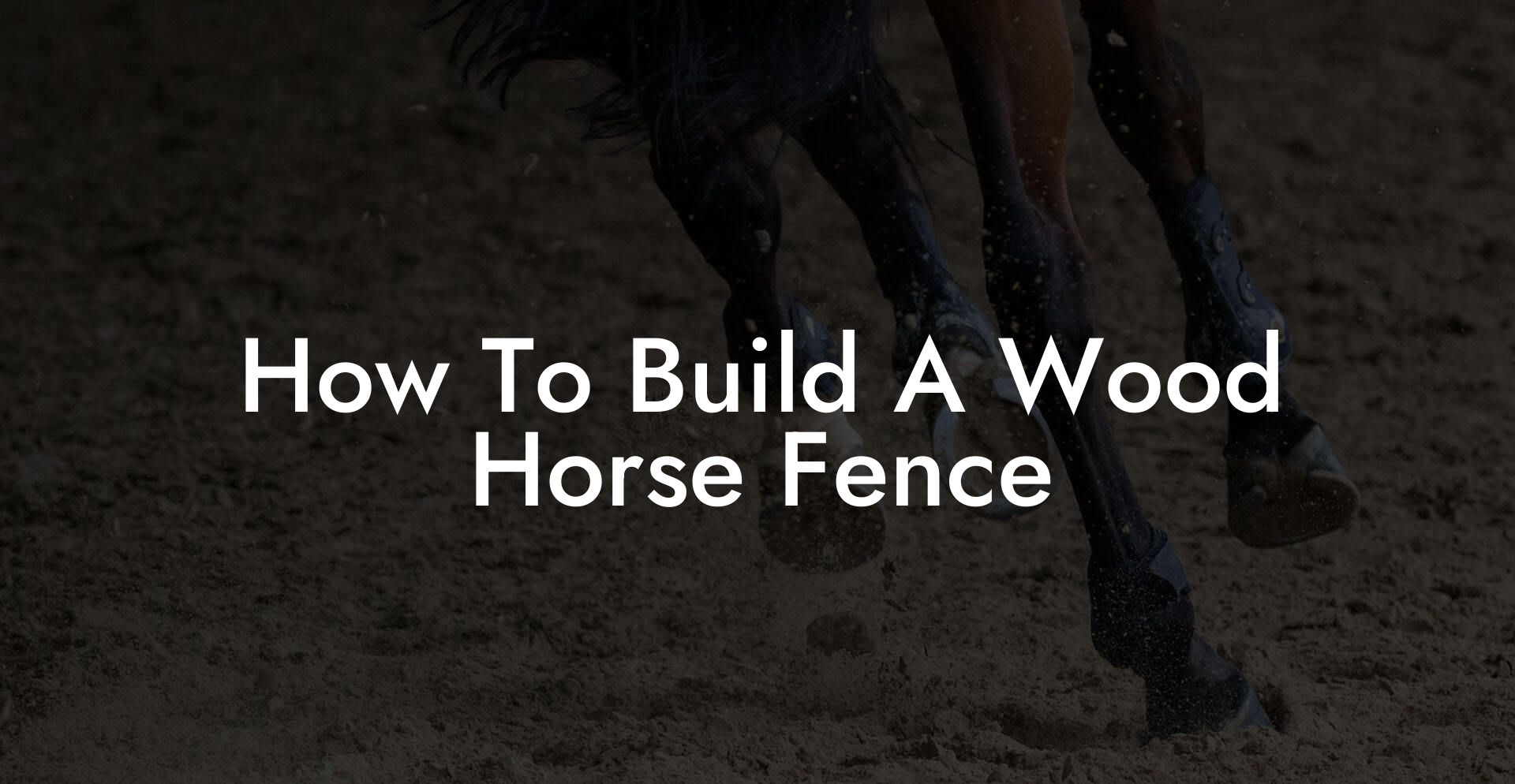Ever wondered how to transform a pile of lumber and some elbow grease into the ultimate sanctuary for your four-legged friend? Building a wood horse fence is more than just hammering nails and slapping boards together, it’s about crafting a safe, stylish, and sustainable barrier that lets your horse roam free while keeping them secure. Whether you’re a DIY newbie or a seasoned handyperson with an eye for design, this guide is here to break down every aspect of constructing a wood fence that not only stands the test of time but also vibes with your Gen-Z/millennial aesthetic.
Quick Links to Useful Sections
- Why Building a Wood Horse Fence Is a Game-Changer
- Project Planning: Setting the Stage For Success
- The Essential Materials and Tools for Your Wood Horse Fence
- Wood: The Building Block of Your Fence
- Posts, Rails, and Boards: The Structure Defined
- Hardware: Nails, Screws, and Brackets
- Tools of the Trade
- Step-by-Step Guide: Building Your DIY Wood Horse Fence
- Step 1: Preparing the Site and Laying Out the Fence
- Step 2: Digging Post Holes and Setting Your Posts
- Step 3: Attaching Rails and Boards
- Best Practices: Ensuring Durability and Safety
- Maintenance: Keeping Your Wood Horse Fence in Top Shape
- Integrating horse care: Creating a Haven for Your Equine Friend
- Design with Your Horse in Mind
- Safe Materials
- Complementary Features
- Troubleshooting Common Issues During and After Construction
- Misaligned Posts
- Uneven Board Spacing
- Wood Rot and Insect Infestations
- Hardware Failures
- Resources and Community Support: Your Next Steps
- DIY Wood Horse Fence FAQ: Your Most Pressing Questions Answered
- Your Journey to Building a Wood Horse Fence That Wows
Why Building a Wood Horse Fence Is a Game-Changer
In today’s era of sustainable projects and hands-on lifestyles, building your own wood horse fence ticks all the boxes: environmental friendliness, cost efficiency, and that unbeatable sense of accomplishment when you see your creation standing proud in your pasture. Plus, a wood fence can be customized to match your personal style, and who doesn’t want their horse’s yard to look Instagram-worthy?
A thoughtfully constructed fence does more than mark boundaries; it establishes a secure space where your horse can safely graze, play, and rest. Unlike chain-link fences or pre-made metal barriers, wood offers a natural look that blends seamlessly with rural landscapes while providing robust protection against predators and escape antics.
By diving into this project, you’re also boosting your DIY cred, saving money, and embracing a hands-on method that reflects modern sensibilities. With sustainable, locally sourced wood and eco-friendly practices, you’re not just building a fence, you’re investing in your horse’s well-being and the health of the planet.
Project Planning: Setting the Stage For Success
Like any epic adventure, a successful wood horse fence project starts with solid planning. Before you pick up that hammer, it’s crucial to map out every detail of your build. From determining the right dimensions to understanding your local building codes, this phase sets the tone for everything that follows.
Start by sketching a rough layout of your pasture and deciding the ideal spot for your fence. Consider the terrain, natural obstacles, and your horse’s daily routines. Do they love lounging in the sun or prefer a shady retreat? Your fence design should effortlessly integrate into your horse’s environment, providing both safety and comfort.
Other key planning points include:
- Design Dimensions: Measure the perimeter of the area you wish to enclose, keeping in mind extra space for maneuverability and additional structures like feeding areas or shelters.
- Local Regulations: Check with your local extension office or municipality about any zoning restrictions, fence height regulations, or permit requirements.
- Budget: Establish a realistic budget by considering both the cost of materials (wood, nails, concrete, etc.) and any potential professional help for tasks you’re less familiar with.
- Timeline: Outline a timeline for your project. From ordering materials to final installation, having a schedule helps prevent mid-project delays and keeps you on track.
With these factors in mind, your planning phase ensures that when you swing that hammer, every cut, nail, and board contributes to a secure, beautiful, and functional structure.
The Essential Materials and Tools for Your Wood Horse Fence
A robust wood horse fence doesn’t just build itself, it requires the right materials and tools. Investing time upfront in choosing quality supplies not only increases the lifespan of your fence but also minimizes unexpected setbacks. Here’s your ultimate checklist:
Wood: The Building Block of Your Fence
Choosing the right type of wood is critical. Cedar, pressure-treated pine, and redwood are popular options due to their natural resistance to rot and pests. Pressure-treated wood is particularly attractive for outdoor projects because it’s designed to withstand the elements without frequent maintenance.
If you’re eco-conscious (and who isn’t these days?), consider sourcing reclaimed wood from local salvage yards. Not only is it great for the planet, but it also adds a unique, rustic look to your fence that you won’t find in store-bought materials.
Posts, Rails, and Boards: The Structure Defined
The backbone of your fence is the wooden posts, which should be sturdy enough to support your rails and boards. Concrete posts work well too, but many DIY enthusiasts prefer the warmth of natural wood. Along with posts, you’ll need horizontal rails that connect the posts and vertical boards that provide the barrier.
When selecting your wood, remember to consider the dimensions of your posts and rails; a thicker wood offers more stability and resistance to environmental stressors.
Hardware: Nails, Screws, and Brackets
A successful fence build depends on durable hardware. Opt for galvanized or stainless-steel nails and screws to prevent rust and corrosion. Metal brackets can add extra support, especially at connection points that might otherwise weaken over time. Investing in high-quality fasteners now can save you from repairs or fence failures down the road.
Tools of the Trade
Equip yourself with a solid set of tools to make the process smooth and enjoyable:
- Post Hole Digger or Auger: Essential for digging deep, stable holes where your fence posts will anchor securely.
- Power Drill and Impact Driver: These speed up the process of fastening rails and boards, making repetitive tasks less laborious.
- Level and Tape Measure: Precision matters in DIY projects. A level ensures that your posts and rails are perfectly aligned, while a tape measure guarantees accurate distances.
- Saw (Circular or Miter): A sharp saw helps make smooth, accurate cuts on your wood planks and rails.
- Hammer and Pry Bar: Classic but indispensable tools for any nail-driven DIY project.
- Concrete Mixer (Optional):
For setting posts in concrete, a portable mixer can be a huge time saver.
Having all these materials and tools on hand makes the difference between a frustrating build and a satisfying, smooth project that even your most skeptical friends will admire.
Step-by-Step Guide: Building Your DIY Wood Horse Fence
Now for the fun part, rolling up your sleeves and getting to work! Below you'll find a detailed breakdown of each step in building your wood fence masterpiece. Follow these stages carefully to ensure your final product is both secure and aesthetically pleasing.
Step 1: Preparing the Site and Laying Out the Fence
First things first, you need to claim your territory. Walk along the edge of your prospective fence line, measure precisely, and mark the layout using stakes and string. It may sound basic, but proper layout prevents uneven posts and misaligned panels that can compromise your fence’s integrity.
Consider natural topography. If your land slopes, you might need to adjust the height of your fence or add extra posts to ensure that the structure remains stable. Also, be mindful of any underground utilities, call your local service before you start digging.
This stage might call for a few laughs with your friends as you wrestle with tangles of string and imperfect measurements. Trust us: even if it gets a bit awkward, attention to detail here will save you headaches later.
Step 2: Digging Post Holes and Setting Your Posts
With your layout in place, it’s time to set the posts. Using a post hole digger or auger, create holes deep enough to ensure stability, typically one-third of the post length should be underground. For a wood fence, 24 to 36 inches deep is standard, but check local guidelines to be sure.
Insert your posts into the holes, making sure they’re perfectly vertical using a level. Then, fill the holes with a mix of gravel and concrete to secure each post firmly. Not only does concrete provide extra stability, but it also helps resist the shifting of soil during heavy rains or frosty winters.
Pro tip: If you’re building your fence during wet weather, add extra gravel at the bottom of each hole for drainage. This simple trick can prevent water from pooling around your posts and rotting the wood over time.
Step 3: Attaching Rails and Boards
With your posts safely in place, it’s time to add the horizontal rails that will connect them and create the framework for your fence. Secure two to three rails per section, ensuring they’re evenly spaced for both aesthetic appeal and added strength.
Once the rails are up, attach the vertical boards or pickets. You can choose a variety of layouts: whether you prefer a classic board-on-board style for extra privacy or evenly spaced gaps for ventilation and better visibility, your fence can be as unique as your horse.
When nailing or screwing the boards into place, aim for symmetry and consistency. Keep in mind that your horse may lean against or even nudge the fence, so ensuring even gaps and secure attachments will maintain the structure’s integrity over time. Experiment with different fasteners or even finish with standoffs to give the fence a modern, elevated look.
As you work, take short breaks to enjoy the satisfaction of progress and maybe snap a selfie with your masterpiece-in-progress. It’s all part of the journey to blending functionality with style.
Best Practices: Ensuring Durability and Safety
A wood horse fence isn’t just a barrier, it’s a vital component of your horse’s daily life. It must be sturdy, reliable, and safe. Here are some best practices to ensure your fence meets the highest standards of durability and safety:
- Smooth Out Sharp Edges: Sand down rough edges and splinters. Your horse might accidentally brush up against these while leisurely grazing.
- Proper Spacing: Ensure there’s adequate space between boards to prevent your horse from getting caught, but not so wide that a determined critter or escape artist can squeeze through.
- Regular Inspections: Commit to seasonal inspections. Look for signs of rot, insect damage, or any loose hardware, and perform repairs as needed.
- Weatherproofing: Treat your wood with appropriate sealants or stains to protect against UV rays, rain, and temperature fluctuations.
- Stable Post Installation: Double-check that concrete set posts are flush with the top of the soil to avoid heaving during freeze-thaw cycles.
Implementing these practices not only prolongs the lifespan of your fence but also protects your favorite equine companion. Remember, a well-maintained fence is as much about aesthetics as it is about safety and longevity.
Maintenance: Keeping Your Wood Horse Fence in Top Shape
Building your fence is only half the battle; maintaining it is where you truly ensure lasting success. Over time, exposure to the elements can take its toll, but regular upkeep can keep your fence looking fresh and functioning flawlessly.
Key maintenance tips include:
- Annual Wash Down: Use a pressure washer or garden hose to remove dirt, mildew, and grime. This simple cleaning step can reveal early signs of wear and tear.
- Inspect and Touch Up: Replace any loose nails, screws, or damaged boards immediately. A small repair now can prevent a larger issue later.
- Seal and Stain: Depending on your local climate, reapply wood sealant or stain every one to two years to guard against moisture and UV damage.
- Post Maintenance: Check the concrete around your posts for cracks or erosion. Top off with extra concrete if necessary to maintain overall stability.
Staying on top of these maintenance tasks will not only enhance the visual appeal of your wood fence but also ensure it remains a safe haven for your horse for years to come.
Integrating horse care: Creating a Haven for Your Equine Friend
When building a wood horse fence, it’s essential to incorporate elements that cater to your horse’s comfort and well-being. After all, a fence isn’t just a physical barrier; it’s part of your horse’s home environment. Here are some horse care considerations to keep in mind:
Design with Your Horse in Mind
Think about accessibility. Your fence should allow your horse to move freely without risk of injury. Adjust board spacing and height according to your horse’s size and behavior. For instance, stallions might be more boisterous compared to mares, so you may opt for a slightly more secure design if temperament is a concern.
Safe Materials
Use non-toxic wood treatments and hardware so that if your horse ever nibbles on a board out of curiosity, there’s little risk of ingestion of harmful chemicals. Your love for your horse should be echoed in the safety standards you apply to every part of your build.
Complementary Features
Consider incorporating additional features that enhance your horse’s environment, such as a viewing window in the fence or sections designed to attach accessories like water troughs and feeders. This not only keeps your horse safe but also deepens their connection with the space.
By marrying sturdy construction with thoughtful design, you create a fence that’s as much about caring for your horse as it is about marking property lines.
Troubleshooting Common Issues During and After Construction
Even the most meticulously planned projects can encounter hiccups along the way. Here are some common issues you might face during your wood horse fence build, and practical tips to troubleshoot them:
Misaligned Posts
It can be frustrating to discover that your posts aren’t perfectly aligned. Use a string line and a good old-fashioned level during installation to correct any discrepancies early on. If you notice misalignment later, don’t panic, minor adjustments with a sledgehammer and some extra concrete can set things straight.
Uneven Board Spacing
Uneven gaps between boards not only look off but can also compromise your fence’s effectiveness. Mark out fixed intervals before attaching the boards to maintain consistent spacing. This not only improves the fence’s aesthetic but also ensures your horse won’t try squeezing through the gaps.
Wood Rot and Insect Infestations
Over time, even top-quality wood can fall prey to rot or pesky insects. Keep an eye on high-humidity areas and ensure your wood is properly sealed. A quick application of a wood preservative can stave off decay and extend the life of your fence.
Hardware Failures
Rusted or loose nails and screws are a common nuisance. Invest in extra high-quality hardware during construction and perform routine checks, tightening or replacing as needed. This proactive approach prevents small issues from ballooning into major maintenance headaches.
Embrace these troubleshooting tips with a sense of humor, every dent, misalignment, or squeak in your fence is just another chapter in your DIY adventure.
Resources and Community Support: Your Next Steps
Feeling inspired to get your hands dirty? The best part about DIY projects is that you’re not alone. Countless online communities, local workshops, and resource centers are ready to provide guidance, support, and even a few laughs along the way.
Check out forums dedicated to DIY fencing projects and horse care, join social media groups where professionals share their tips and hacks, or attend local workshops on sustainable building. Networking with fellow enthusiasts not only enhances your knowledge base but also sparks creative ideas that you can incorporate into your own project.
And if you find yourself stuck on a tricky step, remember: every great DIYer has had their fair share of “oops” moments. Post your questions online, attend community meet-ups, or even consult a local expert who can help troubleshoot on-site issues.
Your journey to building the perfect wood horse fence is as much about the people you meet as it is about the structure itself. Leverage these resources to turn your fence-building adventure into a learning experience and a chance to join a community of like-minded visionaries.
DIY Wood Horse Fence FAQ: Your Most Pressing Questions Answered
Here are some frequently asked questions that tackle the common concerns and challenges when building a wood horse fence:
1. What type of wood is best for building a durable horse fence?
Pressure-treated pine, cedar, and redwood are excellent due to their natural resistance to rot and insects. For an eco-friendlier option, reclaimed wood is a great choice that offers both durability and character.
2. How deep should my post holes be?
Typically, post holes should be dug to about one-third the length of your post, generally ranging from 24 to 36 inches deep depending on your fence height and soil conditions.
3. Can I build the fence myself without professional help?
Absolutely. With careful planning, the right tools, and a bit of patience, many horse owners have successfully built their own wood horse fences. However, if you experience complex issues or have doubts, consulting a professional is always an option.
4. How often should I maintain my wood fence?
A general maintenance routine should involve an annual wash down, routine inspections for loose hardware or decay, and reapplication of sealant every one to two years, depending on your climate.
5. What safety features should I consider for my horse fence?
Ensure smooth edges, secure posts, and appropriate spacing between boards to prevent injuries. Always use non-toxic, weather-resistant treatments, and design with your horse’s size and behavior in mind.
6. Are there any local building codes or permits required?
Building codes vary by location. It’s important to consult your local municipality or extension service to determine if permits or specific guidelines apply to your project.
7. What can I do if I encounter issues with equipment or materials?
Consult local hardware experts or DIY forums online for troubleshooting tips. Sometimes, a minor change in tools or a quick adjustment in technique can resolve what seems like a major setback.
8. How can I make my wood fence more aesthetically appealing?
Consider using decorative trims, stained finishes, or even incorporating unique design elements like lattice work. The goal is to create a balance between functionality and a design that reflects your personality.
Your Journey to Building a Wood Horse Fence That Wows
The process of building a wood horse fence is more than just a construction project, it’s a transformative journey that unites creativity, practical skills, and genuine care for your horse’s safety and comfort. Every measurement taken, every nail hammered, and every board aligned is a step toward creating a space that is secure, aesthetically pleasing, and uniquely yours.
As you embark on this DIY adventure, remember that perfection isn’t found in flawless construction but in the passion and persistence you put into every phase of the project. Let your creativity shine through, and don’t be afraid to add your own personal twists, whether that means incorporating reclaimed materials, experimenting with modern design elements, or simply taking pride in a job well done.
Building a wood horse fence is an ongoing relationship between you, your materials, and the environment you strive to create for your equine companion. Embrace the challenges, celebrate the victories, and view each moment as an opportunity to learn and grow. Before you know it, you’ll have a stunning fence that not only serves as a physical barrier but also as a tribute to your DIY spirit and your unwavering commitment to quality horse care.
So grab your tools, rally your friends, and get ready to embark on a project that marries functionality with a fresh, modern aesthetic. Your horse’s safe haven awaits, and it’s going to be nothing short of spectacular.













